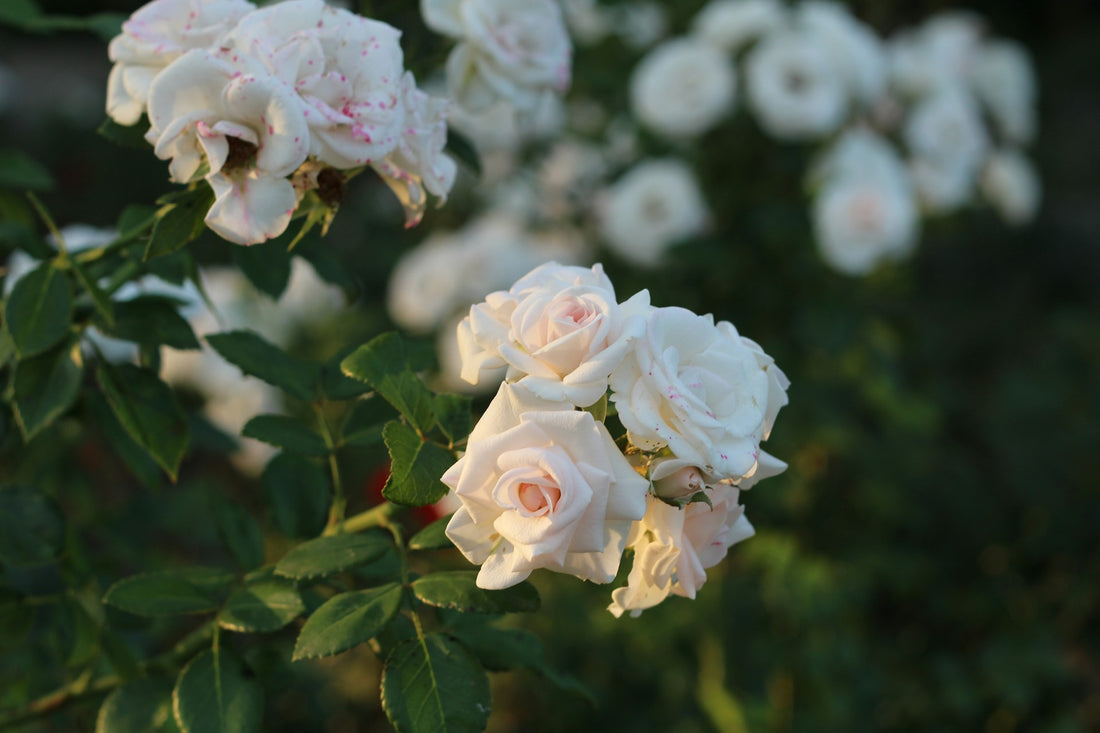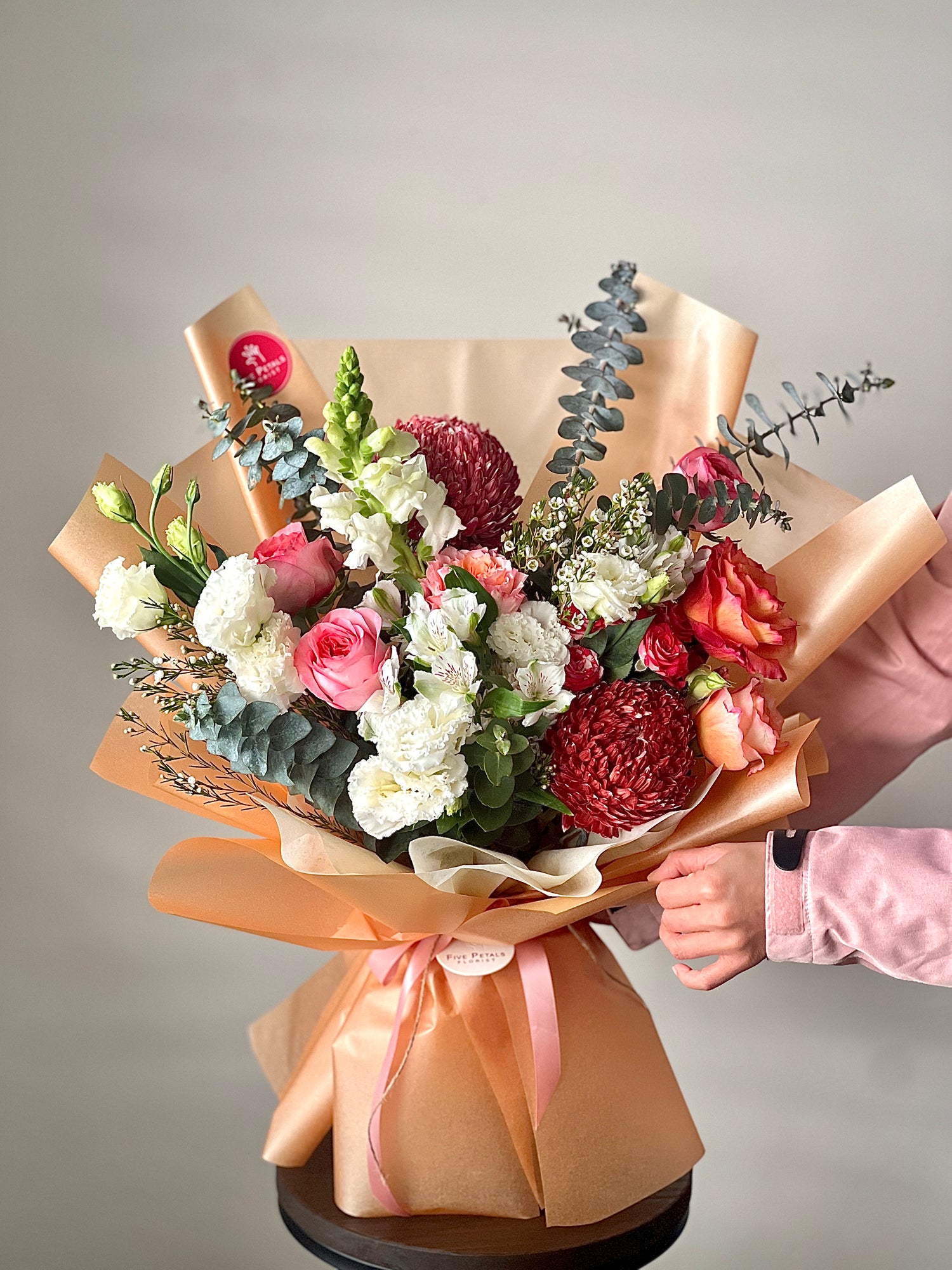The Ultimate Guide to Roses - Growing, Caring, and Arranging in Newcastle & Lake Macquarie

Roses are not just flowers; they are a symbol of love, beauty, and emotion, making them one of the most cherished blooms around the world. From stunning arrangements to fragrant gardens, roses hold a special place in our hearts and homes. In this ultimate guide, we’ll explore everything you need to know about growing, caring for, and arranging roses, specifically tailored for those in Newcastle and Lake Macquarie.
1. Types of Roses
Roses come in a variety of types, each offering unique characteristics and beauty. Here are some popular varieties you might consider:
-
Hybrid Tea Roses: Known for their classic, single blooms on long stems, these are ideal for cutting and arrangements. Hybrid teas are popular for their elegance and fragrance, making them perfect for bouquets.
-
Floribunda Roses: These roses produce clusters of blooms, which are perfect for creating vibrant garden beds. Their abundant flowers bloom throughout the season, making them a favourite for those wanting continuous colour.

Photo by Jonathan Meyer on Unsplash
-
Climbing Roses: Perfect for trellises, arbors, and fences, climbing roses add vertical beauty to any garden. These roses can reach great heights, and their cascading blooms make for a dramatic effect.

Photo by Duskfall Crew on Unsplash
-
Shrub Roses: Hardy and disease-resistant, shrub roses are great for low-maintenance gardens. They offer a natural, bushy form that fills space and creates dense, colourful displays.

Photo by Anastacia Dvi on Unsplash
2. Growing Roses
Growing roses in the Newcastle and Lake Macquarie region requires attention to the local climate. Here’s how you can cultivate beautiful roses in your garden:
Soil Preparation
Roses thrive in well-drained, fertile soil. The ideal soil pH for roses is slightly acidic, between 6.0 and 6.5. It’s a good idea to test your soil pH before planting and amend it with compost or organic matter if necessary.
Planting
Choose a sunny spot where your roses will receive at least 6-8 hours of sunlight daily. Dig a hole large enough for the roots to spread comfortably and mix compost into the soil. Plant your roses slightly above ground level to prevent root rot.
Watering
Water your roses deeply once a week, ensuring the soil stays moist but not soggy. In Newcastle’s warmer climate, you may need to increase watering during the summer months. Early morning watering is best to avoid fungal diseases.
Fertilising
Apply a balanced fertiliser designed for roses in early spring and again in mid-summer to encourage healthy growth and blooming. Organic options like compost or well-rotted manure can also provide nutrients without harmful chemicals.
Sunlight
Roses need full sun to thrive. Ensure they get at least 6 hours of direct sunlight daily to promote healthy growth and abundant blooms. In hotter months, afternoon shade can help prevent scorching.
3. Caring for Roses
Once planted, roses require consistent care to thrive. Here are the most important aspects of rose care:
Pruning
Prune your roses in early spring before new growth begins. Remove dead or weak branches, and shape the bush to improve airflow. Pruning encourages healthier growth and more blooms during the growing season.

Photo by Melanie Sykes on Unsplash
Pest and Disease Management
Roses are susceptible to pests like aphids and spider mites. Use organic treatments such as neem oil or insecticidal soap to keep them at bay. For diseases like black spot and powdery mildew, remove affected leaves and consider using organic fungicides.
Mulching and Weeding
Mulch around your roses to retain moisture and suppress weeds. This also helps regulate soil temperature, especially during hot summer months. Regularly remove weeds that may compete for nutrients.
4. Symbolism of Roses
Roses hold deep meanings across various cultures and contexts. Each color tells a unique story:
- Red Roses: The universal symbol of love and passion.

Photo by Biel Morro on Unsplash
- White Roses: Represent purity, innocence, and new beginnings, often used in weddings.

Photo by Galina N on Unsplash
- Yellow Roses: Symbolise friendship and joy, making them ideal for celebrating special moments.

Photo by Daniel Jerez on Unsplash
- Pink Roses: Convey admiration, gratitude, and happiness, suitable for any occasion.

Photo by Elliot Cullen on Unsplash
Understanding the symbolism of roses can help you choose the perfect variety for your next arrangement or gift.
5. Arranging Roses
Creating stunning rose arrangements is a rewarding way to display these beautiful blooms:
Bouquet Ideas
Combine different colors of roses for a vibrant bouquet. Use hybrid teas for a classic, elegant arrangement, or mix in floribundas for a fuller, more abundant look. Adding foliage like eucalyptus or ferns creates texture and contrast.
Photo by Joyous Chan on Unsplash
DIY Tips
Start with a clean vase filled with fresh water and flower food. Cut stems at an angle and remove excess leaves to prevent bacteria from growing in the water. Change the water every 2-3 days to keep your roses fresh for as long as possible.
Pairing Roses with Other Flowers
Roses pair beautifully with lilies, daisies, or even wildflowers for a natural yet sophisticated look. Greenery such as ivy or fern adds contrast, while soft blooms like peonies or hydrangeas enhance the romantic feel.
6. Preserving Roses
To enjoy your roses long after they’ve bloomed, try these preservation techniques:
Drying Roses
Hang your roses upside down in a dry, dark place for several weeks to allow them to retain their color and shape. Once dried, they can be used in decorative arrangements or even as keepsakes.

Photo by Tim Mossholder on Unsplash
Displaying Preserved Roses
Place dried roses in clear glass containers or shadow boxes for a rustic, timeless display. This technique not only preserves the beauty of the blooms but also adds an elegant touch to your home decor.
7. Rose Varietals and Cultivars
For those looking to add unique roses to their garden, here are a few popular cultivars:
- David Austin Roses: Known for their rich fragrance and old-fashioned blooms, David Austin roses are hybrids that combine the best of traditional and modern roses.
- Climbing Roses: Popular varieties like ‘Iceberg’ or ‘Pierre de Ronsard’ are perfect for creating vertical interest in gardens.
- Miniature Roses: Ideal for small spaces or container gardening, these tiny beauties can bring color to patios or windowsills.
8. Seasonal Considerations
Roses need different care throughout the year. Here’s how to adjust your routine based on the season:
Spring
This is the time for planting, fertilising, and pruning. Fresh growth begins in spring, and ensuring proper care now will lead to healthier blooms later in the year.
Summer
Keep your roses well-watered during the hotter months. Deadhead (remove spent flowers) regularly to encourage continued blooming.
Autumn
As temperatures cool, reduce watering and fertilising. Begin preparing your roses for winter by applying a fresh layer of mulch to insulate the roots.
Winter
Roses go dormant in winter. Protect them from frost with a thick layer of mulch, and prune any dead or damaged branches before spring.
9. Common Mistakes to Avoid in Rose Care
While growing roses can be rewarding, it’s easy to make mistakes. Here are some common pitfalls to avoid:
- Overwatering: Too much water can lead to root rot and other diseases. Ensure proper drainage and only water deeply once a week.
- Under-Pruning: Failing to prune can lead to overcrowded branches, reducing airflow and increasing the risk of disease.
- Improper Spacing: Planting roses too close together can limit air circulation, making them more susceptible to fungal infections like black spot.
- Neglecting Sunlight: Roses need at least 6 hours of sunlight each day. Lack of sunlight results in fewer blooms and weaker plants.
10. Rose-Related Products
Consider adding these products to your rose care routine:
- Organic Fertilisers: Using slow-release organic fertilisers provides essential nutrients without harmful chemicals.
- Pesticides: Opt for organic pesticides to keep your roses free of pests without compromising the environment.
- Gardening Tools: Invest in quality pruners, gloves, and a watering can to make caring for your roses easier and more enjoyable.
11. Environmental Impact and Sustainability
To care for your roses while keeping an eye on sustainability:
- Minimise Pesticides: Use organic pest control methods like neem oil or introduce beneficial insects such as ladybugs to manage pests.
- Water Conservation: Mulching helps reduce water loss, and watering early in the morning minimises evaporation.
- Promote Pollinator-Friendly Gardens: Roses attract bees, butterflies, and other pollinators. Choose varieties that are known to be particularly attractive to these beneficial insects.
12. Frequently Asked Questions (FAQs)
How often should I water my roses?
Water your roses deeply once a week, ensuring the soil remains moist but not soggy.
What are the most common diseases affecting roses?
Common diseases include black spot, powdery mildew, and rust. Regular monitoring, proper spacing, and preventive treatments can help manage these issues.
When is the best time to plant roses?
The ideal time to plant roses in Newcastle and Lake Macquarie is in early spring, after the last frost.
Can I grow roses in pots?
Yes, many rose varieties thrive in pots. Just ensure the pot has good drainage and use a well-balanced fertiliser.
What are the best companion plants for roses?
Consider planting lavender, marigolds, or geraniums near your roses to repel pests and enhance the beauty of your garden.
With these tips, you’ll be well-equipped to grow, care for, and arrange roses like a pro, whether you’re a gardener in Newcastle, Lake Macquarie, or beyond.
To send Roses to Newcastle, Lake Macquarie or the surrounding, check out our exquisite Rose Collection for bouquet, vase and box.


